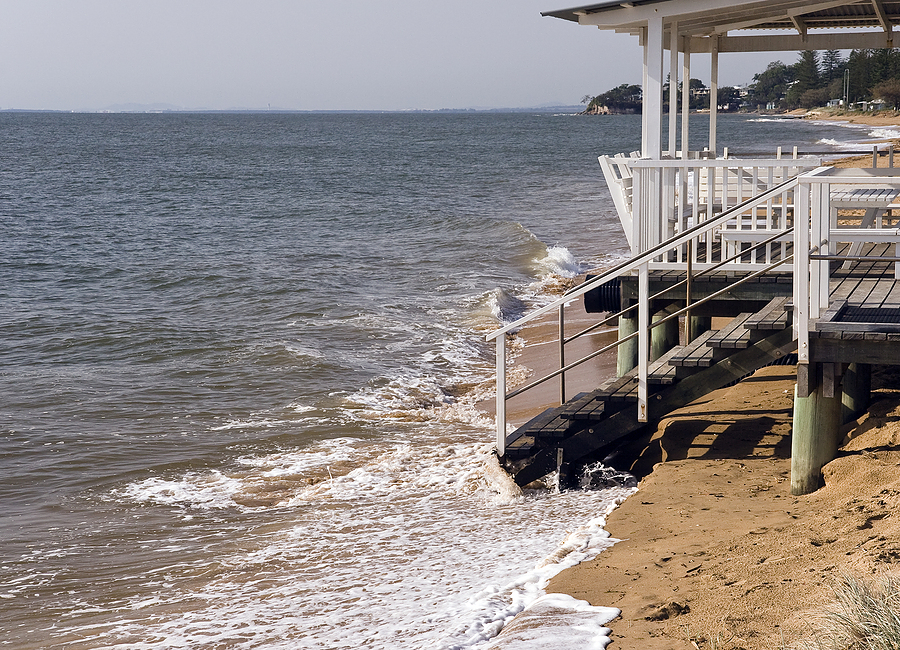When Miami Beach borrowed $162 million from Wall Street this week, it wanted investors to know rising seas and extreme weather are a real risk to the city and that it’s doing something about it.
An increasing number of states and local governments are including climate change in their list of risks investors should consider before buying their bonds. There’s good reason. BlackRock Inc., the world’s largest asset manager, says that within a decade, more than 15 percent of debt in the S&P National Municipal Bond Index will come from regions that could suffer losses from climate change adding up to as much as 1 percent of gross domestic product annually.
“Climate is becoming a bigger and bigger part of calculating risk in our market,” said Eric Glass, a portfolio manager for fixed income impact strategies at AllianceBernstein. “We have to take these things into consideration as we build out our portfolios.”
Miami Beach, which sits on a barrier island off the southeastern coast of Florida, devotes more than two pages in its official bond offering document to climate change, saying city officials are “keenly aware of the risks from hurricanes and sea level rise.”
History Lesson
That warning is warranted. The picturesque beach destination along with Sarasota on the state’s western coast, are among the most exposed cities to climate change in the country, according to an analysis last year by advisory firm Four Twenty Seven.
Recent history has investors concerned:
Puerto Rico was decimated by Hurricane Maria in 2017, a disaster that all but destroyed the already-bankrupt island’s electricity grid and set back efforts to settle with bond holders and to emerge from bankruptcy court. Superstorm Sandy caused some $70 billion in damages when it slammed into the Eastern seaboard in 2012, flooding half of Hoboken and parts of lower Manhattan and Wall Street and inundating subways. California wildfires, which have intensified in severity because of climate change, in part sent PG&E Corp., the state’s largest power company, into bankruptcy amid mounting liability costs.BlackRock developed a model which uses climate data to analyze the physical risks and probabilities of flooding and hurricane force winds on a granular level across the U.S. The company’s research found that Coastal Florida, the Gulf Coast region — which was recently battered by Hurricane Harvey — and Arizona because of extreme heat, are most susceptible to economic losses from climate change.
“Our early findings suggest investors must rethink their assessment of vulnerabilities,” BlackRock’s Global Chief Investment Strategist Richard Turnill wrote in a research note this week. “Climate-related risks already threaten portfolios today, and are set to grow.”
Paying Attention
Miami Beach asked voters last year to approve $439 million in general obligation bonds, a fourth of which would be used to directly address the effects of climate change. The measure passed overwhelmingly. A portion of the latest sale will be used for infrastructure and capital improvements, including storm-water, flooding and mitigation efforts. The bonds priced with spreads ranging from 3 basis points for debt maturing in 2020 to 82 basis points on debt with a 3.25 percent coupon maturing in 2049, according to data collected by Bloomberg.
San Francisco voters passed a referendum for a revitalized sea wall and Harris County, Texas — home to 4.65 million people — approved flood bonds a year after Harvey dumped a record amount of water on the region in 2017. New York Mayor Bill de Blasio last month proposed a $10 billion plan to push out the lower Manhattan coastline as much as 500 feet, or two city blocks, to protect from flooding that’s expected to become more frequent as global temperatures rise.
In the meantime, investors are mindful that municipalities can borrow money for 30 years out and a lot of catastrophic weather can happen in that time. All five of the costliest hurricanes on record — Katrina, Harvey, Maria, Sandy and Irma– hit in the last 15 years, according to the National Oceanic and Atmospheric Administration.
“Does Miami Beach look like what we know Miami Beach to look like in 25 or 30 years?” Glass said.
Was this article valuable?
Here are more articles you may enjoy.


 Instacart to Pay $60 Million in FTC Consumer Protection Case
Instacart to Pay $60 Million in FTC Consumer Protection Case  Waymo to Update Software Across Fleet After Major Power Failure
Waymo to Update Software Across Fleet After Major Power Failure  Wells Fargo Sued by Ex-Manager Who Said Bank Faked Diversity
Wells Fargo Sued by Ex-Manager Who Said Bank Faked Diversity  Insurance AI Demo Day Calendar Announced
Insurance AI Demo Day Calendar Announced 